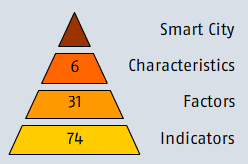
 |
 |
||||||||||||||||
The smart city model A Smart City is a city well performing in 6 characteristics, built on the ‘smart’ combination of endowments and activities of self-decisive, independent and aware citizens.
z-transformation To receive results on the level of factors, characteristics and the final result for each city it is necessary to aggregate the values on the indicator level. For the aggregation of indicators of factors we consider also the coverage rate of each indicator. A certain result from an indicator of an indicator covering all 70 cities weights therefore a little more than from an indicator covering only 60 cities. Besides this small correction the results were aggregated on all levels without any weighting. The aggregation was done additive but divided through the number of values added. That allows us to include also cities which do not cover all indicators. Their results are calculated with the values available. Still, it is necessary to provide a good coverage over all cities to receive reasonable results. For the 70 cities by 74 indicators we achieve a coverage rate of 87 %. Smart Economy Smart Mobility Smart Environment Smart People Smart Living Smart Governance |
|






